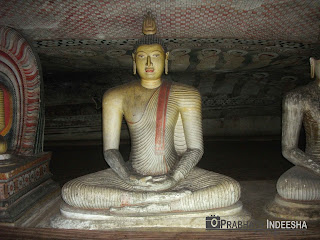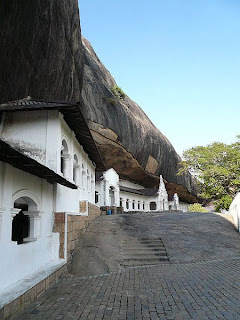Sri Lanka
Sunday, April 28, 2013
Dambulla cave temple
Dambulla cave temple (Sinhala: දඹුලු ලෙන් විහාරය dam̆būlū len vihāraya, Tamil: தம்புள்ளை பொற்கோவில் tampuḷḷai poṟkōvil) also known as the Golden Temple of Dambulla is a World Heritage Site (1991) in Sri Lanka, situated in the central part of the country. This site is situated 148 km east of Colombo and 72 km north of Kandy. It is the largest and best-preserved cave temple complex in Sri Lanka. The rock towers 160 m over the surrounding plains.There are more than 80 documented caves in the surrounding area. Major attractions are spread over 5 caves, which contain statues andpaintings. These paintings and statues are related to Lord Buddha and his life. There total of 153 Buddha statues, 3 statues of Sri Lankan kings and 4 statues of gods and goddesses. The latter include two statues of Hindu gods, the god Vishnuand the god Ganesh. The murals cover an area of 2,100 square metres. Depictions on the walls of the caves include the temptation by the demon Mara, and Buddha's first sermon.
Prehistoric Sri Lankans would have lived in these cave complexes before the arrival of Buddhism in Sri Lanka as there are burial sites with human skeletons about 2700 years old in this area, at Ibbankatuwa near the Dambulla cave complexes.
Sri Lanka
Sri Lanka (pronunciation: /sriːˈlɑːŋkə/, /sriːˈlæŋkə/ or  i/ʃriː ˈlɑːŋkə/;[8][9] Sinhala: ශ්රී ලංකාව, śrī laṃkā, Tamil: இலங்கை,ilaṅkai), officially the Democratic Socialist Republic of Sri Lanka, is an island country in the northern Indian Ocean off the southern coast of the Indian subcontinent in South Asia. Known until 1972 as Ceylon (pron.: /sɨˈlɒn/, /seɪˈlɒn/, or /siːˈlɒn/), Sri Lanka has maritime borders with India to the northwest and the Maldives to the southwest.
i/ʃriː ˈlɑːŋkə/;[8][9] Sinhala: ශ්රී ලංකාව, śrī laṃkā, Tamil: இலங்கை,ilaṅkai), officially the Democratic Socialist Republic of Sri Lanka, is an island country in the northern Indian Ocean off the southern coast of the Indian subcontinent in South Asia. Known until 1972 as Ceylon (pron.: /sɨˈlɒn/, /seɪˈlɒn/, or /siːˈlɒn/), Sri Lanka has maritime borders with India to the northwest and the Maldives to the southwest.
Sri Lanka's documented history spans three thousand years.[10] Its geographic location and deep harbours made it of great strategic importance from the time of the ancient Silk Road[11] through to World War II.[12] Sri Lanka is a diverse country home to many religions, ethnicities and languages.[13] The Sinhalese are the majority, although there are many ethnic minorities, including Sri Lankan Tamils, Moors, Indian Tamils, Burghers, Malays, Kaffirs and the aboriginal Vedda.[14] Sri Lanka has a rich Buddhist heritage, and the first known Buddhist writings were composed on the island.[15] The country's recent history has been marred by a thirty-year civil war which decisively but controversially[16] ended in a military victory in 2009.[17]
Sri Lanka is a republic and a unitary state governed by a presidential system. The capital, Sri Jayawardenapura-Kotte, is a suburb of the largest city, Colombo. An important producer of tea, coffee, gemstones, coconuts, rubber and the nativecinnamon,[18] Sri Lanka has been called The tear drop of India because of its shape and location and is known as "The Pearl of the Indian Ocean" because of its natural beauty. It is also known as "The nation of smiling people".[19] The island containstropical forests, and diverse landscapes with high biodiversity..
Subscribe to:
Posts (Atom)


